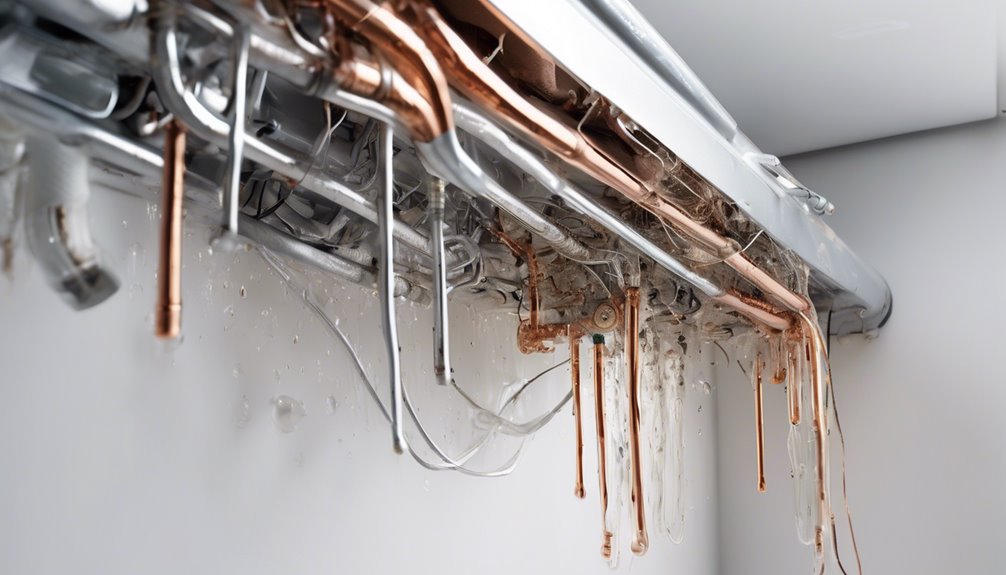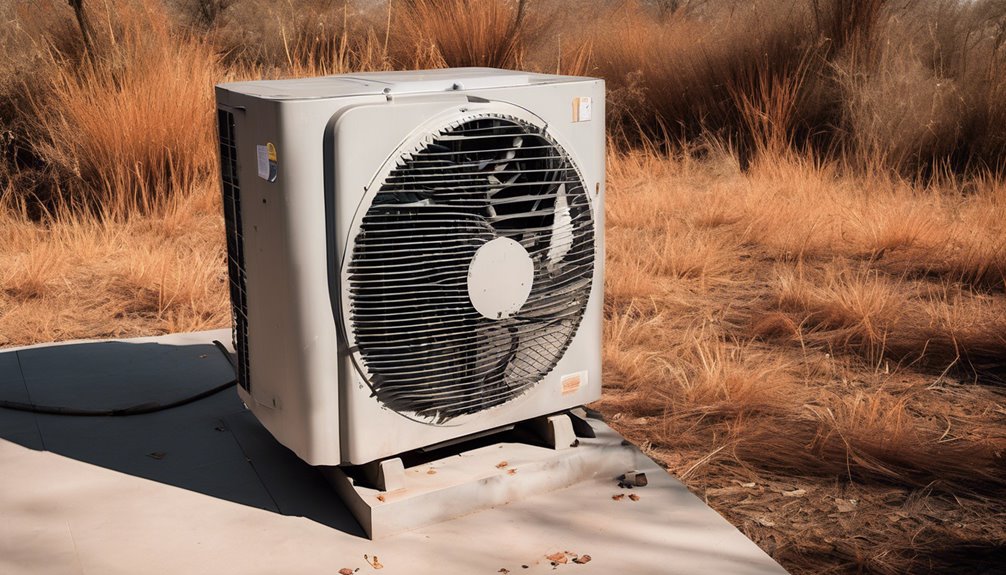To unclog your AC drain pipe, start by identifying the problem – look for signs like water damage, rust, or corrosion around the unit, or a musty smell indicating a blockage. Gather necessary tools like a drain snake, pliers, and a bucket. Then, shut off the power to the unit and locate the drain pipe, usually near the indoor unit. Remove visible debris and use a drain snake to clear the blockage. If you're unsure or the problem persists, consider seeking professional help to avoid further damage.
Key Takeaways
- Identify signs of a clogged AC drain pipe, including water damage, rust, corrosion, musty smells, and mold growth around the unit.
- Gather necessary tools, including a drain snake, pliers, screwdriver, bucket, and personal protective gear, before attempting to unclog the pipe.
- Shut off power to the AC unit and locate the drain pipe, usually near the indoor unit, to access the clog and prevent electrical shock.
- Remove visible debris and blockages, and use a drain snake or cleaner to clear the pipe, then flush with hot water to ensure proper drainage.
- Regularly maintain the drain by cleaning it monthly, using a drain screen, and avoiding harsh chemicals to prevent future clogs.
Identify the Problem
If your air conditioner isn't cooling properly, or water is pooling around it, chances are you have a clogged AC drain pipe.
This common issue can lead to more severe AC drain issues and drainage problems if left unaddressed. Check your AC unit for signs of water damage, rust, or corrosion, which can indicate a blockage in the drain pipe.
You might also notice a musty smell or mold growth around the unit. If you're experiencing any of these symptoms, it's likely that your AC drain pipe is clogged and needs attention.
Identifying the problem early on can save you from more costly repairs down the line.
Gather Necessary Tools and Materials
You'll need to gather some essential tools to tackle the clog, including a drain snake, pliers, and a wrench.
Additionally, you'll want to have some replacement drainage pipe materials on hand, such as PVC pipes and fittings.
Don't forget to grab some personal protective gear, including gloves and safety goggles, to keep yourself safe during the process.
Essential Tools Needed
Gather the following essential tools and materials to ensure a successful unclog of your AC drain pipe: a wet/dry vacuum, a plumber's snake, needle-nose pliers, a screwdriver, and a bucket to catch any spilled water.
You'll need these tools to perform effective drain maintenance and pipe inspection. The wet/dry vacuum will help you remove any blockages, while the plumber's snake will allow you to reach deep into the pipe.
The needle-nose pliers will come in handy for removing stubborn debris, and the screwdriver will help you access the drain pipe's cover. With these tools, you'll be well-equipped to tackle the task at hand and get your AC drain pipe flowing freely again.
Drainage Pipe Materials
The type of material used for your AC drain pipe can greatly impact its performance and maintenance needs.
When it comes to choosing the right material, you have a few options to consider.
- PVC pipes are a popular choice due to their PVC advantages, including resistance to corrosion and ease of installation.
- Copper pipes, on the other hand, are known for their Copper durability and can withstand high water pressure.
- You may also come across aluminum or galvanized pipes, which are lightweight and resistant to rust.
Make sure to choose a material that suits your AC unit's specific needs and your budget.
Personal Protective Gear
Before you dive into unclogging your AC drain pipe, make sure to prioritize your safety by wearing personal protective gear. This is crucial to prevent injuries and exposure to harmful substances.
| Protective Gear | Importance/Benefits | Why You Need It |
|---|---|---|
| Gloves | Protect hands from sharp edges, cuts, and abrasions | Prevent hand injuries while handling pipes and tools |
| Mask | Filter out dust, debris, and mold spores | Prevent respiratory issues and allergic reactions |
| Safety Goggles | Shield eyes from flying particles and chemicals | Prevent eye injuries and vision impairment |
Shut Off the Power to the AC Unit
You'll need to shut off the power to the AC unit before you start working on the clogged drain pipe.
Find the circuit breaker that controls the AC unit and flip the switch to turn it off. Additionally, check the AC switch itself to ensure it's also turned off.
Find the Circuit Breaker
Shut down the air conditioner to prevent electrical shock or injury by locating the circuit breaker that controls the AC unit's power supply.
This crucial step ensures your electrical safety while working on the AC drain pipe.
To find the circuit breaker, check:
- The main electrical panel, usually located in a basement or garage
- A separate breaker box dedicated to the AC unit
- The AC unit itself, as some models have a built-in breaker
Check the AC Switch
Now that you've located the circuit breaker, it's time to verify the AC unit's power is off. Make sure the switch is flipped to the "off" position. This is a crucial step in AC maintenance and electrical safety. You don't want any accidental startups while you're working on the drain pipe.
| Step | Action |
|---|---|
| 1 | Locate the AC switch |
| 2 | Flip the switch to "off" |
| 3 | Double-check the power is off |
| 4 | Verify the unit is not humming |
| 5 | Proceed with unclogging the drain pipe |
Locate the Drain Pipe and Access Point
The air conditioner's drain pipe is usually located near the indoor unit, often behind or beneath it.
This pipe plays a crucial role in condensation management, allowing water to drain out of the system.
You'll need to identify the drain pipe's routing to access the clog.
To find the access point, look for:
- A small pipe or tube connected to the indoor unit
- A drainage tray or pan underneath the unit
- A removable grille or cover that provides access to the pipe
Remove Debris and Blockages
You've located the access point, and it's time to tackle the clog head-on. Remove any visible debris, such as dirt, leaves, or twigs, that may be obstructing the pipe. Use a soft-bristled brush or a cloth to wipe away any dirt or grime that's accumulated on the pipe's surface.
| Debris Type | Common Sources | Blockage Prevention |
|---|---|---|
| Dirt and Dust | Outdoor environment, nearby construction | Regularly clean the AC unit and surrounding area |
| Leaves and Twigs | Nearby trees, plants | Trim nearby foliage, install a leaf guard |
| Hair and Fibers | Human or pet hair, clothing | Use a drain screen or filter |
| Insects and Rodents | Nearby nests, food sources | Seal entry points, keep the area clean |
| Mineral Buildup | Hard water, mineral-rich soil | Use a water softener, regular maintenance |
Use a Drain Snake or Auger
Insert the drain snake or auger into the access point, slowly feeding it into the pipe while rotating the cable to help it navigate any bends or turns.
This will allow you to reach deep into the pipe and break up any clogs. As you feed the snake or auger, you may feel resistance when it hits the clog. Hold the snake or auger steady and gentle apply pressure to help break up the clog.
To keep your AC drain pipe flowing freely, remember:
- Regular snake maintenance can help prevent clogs from forming in the first place
- Keeping the drain pipe clean and clear of debris can go a long way in clog prevention
- Using a drain snake or auger regularly can help identify potential problems before they become major issues
Inspect and Clean the Drain Pan
Now that you've successfully used a drain snake or auger to break up any clogs, it's time to inspect and clean the drain pan.
During pan inspection, look for any signs of rust, corrosion, or mineral buildup that could restrict condensate flow. Check the pan's drain hole for blockages and make sure it's not clogged with debris.
Use a soft-bristled brush or cloth to wipe away any dirt, dust, or algae that may have accumulated. Cleaning the drain pan ensures condensate water can flow freely, reducing the risk of future clogs.
Make sure the pan is dry and free of obstructions before moving on to the next step.
Test the Drain Pipe
The drain pipe is the final hurdle in ensuring your AC unit's condensate drainage system is functioning properly.
Now that you've cleaned the drain pan, it's time to test the drain pipe to ensure it's flowing freely.
To do this, you'll need to perform a pipe inspection to identify any blockages or kinks.
- Check the pipe's exterior for signs of damage or rust.
- Use a flashlight to peer into the pipe and look for any visible debris.
- Run water through the pipe to ensure it's draining properly, and listen for any gurgling or bubbling sounds that could indicate a blockage.
Frequently Asked Questions
Can I Use a Plumbing Snake on My AC Drain Pipe?
You're wondering if a plumbing snake can help with your clog issue. Yes, you can use a snake for drain maintenance, and it's often effective at breaking up minor clogs, but its effectiveness depends on the type and severity of the blockage.
How Often Should I Clean My AC Drain Pipe?
You should establish regular maintenance schedules to prevent clogs, and consider seasonal inspections to ensure your system runs smoothly, ideally every 3-6 months, or as recommended by your AC unit's manufacturer.
What Happens if I Don't Unclog My AC Drain Pipe?
If you don't address the issue, you'll face moisture buildup, leading to water damage and mold growth, which can spread to other parts of your home, causing costly repairs and health hazards, all because you didn't unclog that AC drain pipe.
Can I Use Bleach to Clean My AC Drain Pipe?
You're wondering if bleach can be your go-to cleaner, but here's the deal: while bleach might kill mold and mildew, its effectiveness is limited, and it can corrode pipes, making regular drain maintenance even more crucial.
Will a Clogged AC Drain Pipe Increase My Energy Bill?
You'll likely see high energy bills if your air conditioner's drain pipe is clogged, as the system has to work harder to cool your space, reducing drain functionality and increasing your energy consumption.
Conclusion
You've successfully unclogged your AC drain pipe! Now, turn the power back on and let your AC unit run for a few minutes to test the drain. Check the drain pan for water accumulation and look for signs of leaks. If everything looks good, you've fixed the issue. If not, you may need to call a professional for further assistance. Remember to check and clean your AC drain pipe regularly to avoid future clogs and water damage.


